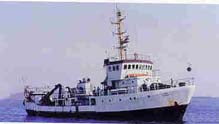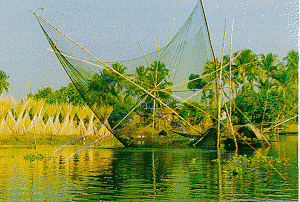
CENTRAL INLAND CAPTURE FISHERIES RESEARCH INSTITUTE BARRACKPORE ,WEST BENGAL

Central Inland fisheries research station was formally established on 17 march , 1947 in calcutta under the ministry of Food and Agriculture , Government of India . From the modest beginning as an interim scheme , the organisation has grown to the status of a premier research institution in the field of inland fisheries in the country and has completed 50 years of its existence on march , 1997.
MANDATE
The CIFRI is presently mandated to :
ORGANISATION
In tune with the above mandate , the research activities of CIFRI have been organised under seven divisions ,corresponding to major fishery resources an other research needs of the country related to fisheries development.
The Riverine division ,with its headquarters at Allahabad , strives to develop systems for effective management of the vast riverine fisheries resources of the research projects under the division covers rivers ganga ,brahmaputra , mahanadi and narmada and their important tributaries .
The Reservoir Division is based at Bangalore with centres in Tamil nadu , Andhra pradesh and Madhya pradesh . The investigations being carried out at the division are aimed at developing management norms for optimising fish yield from large , medium and small reservoirs of the country .
The Barrackpore - based Estuarine Division , presently works on the Hooghly - Matlah and Narmada Estuarine systems.
The Environmental Monitoring and Fish Health Protection Division: The studies under the division includes collection of information of habitat variables , impact identification through known indicators an biodiversity, screening of toxicants in controlled conditions .
The Floodplain Wetlands Division has its headquarters at Barrackpore .The Division carries out research on the ecosystem processes and fish productivity from this resource with special attention on protection of biodiversity and development of environment -friendly technologies .
The Resource Assessment Division is located at Barrackpore The division is geared up to develop various population models that can leads to scientific exploitation of inland fisheries resources .
Hilsa division at Maldah ,West Bengal is to carry out research on biology , life habitats and behaviour of hilsa , leading to development of measures for the recovery of its fishery in the depleted stretches of river ganga .
IMPORTANT ACHIEVEMENTS
New light on the population dynamics of estuarine fishes
Critical analyses on fish population dynamics in Hooghly - Matlah estuarine system have resulted in interesting findings . The fishing mortality worked out for the current year was at very low level of F = 2 .81 for L.parsia , compared to higher value of F= 4.91 recorded during 1987-89. The reduction in fishing intensity resulted in an increase in fish catch from 14.72 t to 19.23 t . an increase of 31%. This indicates higher fishing pressure even at present .
New lights on population dynamics of estuarine fish , Pama pama
The mortality rates of the fish were worked out at Pama Pama . The total mortality rate was found to be Z = 10.17 with fishing mortality at F= 8.584 .
Microbiological profile of river ganga .
As a part of environmental monitoring of the riverine ecosystem , the institute has studied bacterial load of river ganga . The highest bacteria count was recorded as of 572 x 10^4 at Nurpur and lowest of 22 x 10^4 at patna .
Fish and prawn disease
As a part of fish /prawn monitoring programme. White spot disease was detected in 16 bheries causing serious epizootics in penaeus monodon .
|
|
|
|